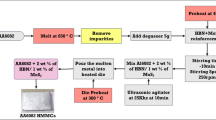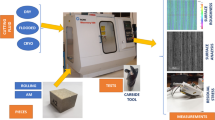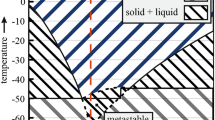Abstract
The integration of machining as a post-processing method for additive manufacturing (AM) can promote the industrialization of AM and enable it to meet the requirements of high-value industries. This integration introduces several challenges for the machining process, which are related to process design and planning. A major aspect that requires investigation is the cooling of the machining process. Effective cooling is a key part of the machining process, especially when hard materials with low machinability are involved, which is the case with parts built by AM. However, oil-based coolants cannot be utilized in the context of hybrid manufacturing because they contaminate the surface of the part that can lead to the introduction of defects in a successive AM process. Cryogenic cooling is a high-performance and sustainable cooling approach that can be employed to overcome this issue, since it provides a clean surface after the machining process. Although cryogenic cooling is a very promising and sustainable alternative for high-performance cooling, most studies only investigate limited benefits that it can provide in the machining process. Therefore, this paper aims to provide a full overview of the effect of cryogenic cooling with liquid nitrogen (LN2) during milling of Directed Energy Deposited IN718 samples, examining the cutting forces, tool wear, surface roughness and residual stresses on the machined components. The results prove that cryogenic cooling can reduce significantly the cutting forces and tool wear, while its impact on the surface roughness is limited.
















Similar content being viewed by others
Data availability
Not applicable.
Code availability
Not applicable.
Abbreviations
- AM:
-
Additive Manufacturing
- ADoC:
-
Axial depth of cut
- CMOS:
-
Complementary Metal oxide semiconductor
- DED:
-
Directed Energy Deposition
- EBM:
-
Electron Beam Melting
- HDM:
-
Hole-drilling strain-gage method
- HRA:
-
Heat-resistant alloy
- LCO2 :
-
Liquid carbon dioxide
- LMD:
-
Laser Metal Deposition
- LN2 :
-
Liquid nitrogen
- MQL:
-
Minimum Quantity Lubrication
- PVD:
-
Physical Vapor Deposition
- RDoC:
-
Radial depth of cut
- \({{\varvec{f}}}_{{\varvec{z}}}\) :
-
Feed per tooth [mm]
- \({\varvec{h}}\) :
-
Undeformed chip thickness
- \({{\varvec{h}}}_{{\varvec{c}}}\) :
-
Deformed chip thickness
- \({{\varvec{K}}}_{{\varvec{t}}{\varvec{c}}},\boldsymbol{ }{{\varvec{K}}}_{{\varvec{r}}{\varvec{c}}},\boldsymbol{ }{{\varvec{K}}}_{{\varvec{a}}{\varvec{c}}}\) :
-
Cutting force coefficients in the tangential, radial, and axial direction [N/mm2]
- \({{\varvec{K}}}_{{\varvec{t}}{\varvec{e}}},\boldsymbol{ }{{\varvec{K}}}_{{\varvec{r}}{\varvec{e}}},\boldsymbol{ }{{\varvec{K}}}_{{\varvec{a}}{\varvec{e}}}\) :
-
Edge force coefficients in the tangential, radial, and axial direction [N/mm]
- \({{\varvec{r}}}_{{\varvec{C}}}\) :
-
Chip compression ratio
- \({{\varvec{v}}}_{{\varvec{C}}}\) :
-
Cutting speed [m/min]
- \({\boldsymbol{\varphi }}_{{\varvec{C}}}\) :
-
Shear angle [rad]
- \({\boldsymbol{\varphi }}_{{\varvec{j}}}\) :
-
Immersion angle of jth cutting edge [rad]
References
Chryssolouris George (2006) Manufacturing systems: theory and practice, 2nd edn. Springer Verlag, New York, USA
Lianos AK, Bikas H, Stavropoulos P (2020) A shape optimization method for part design derived from the buildability restrictions of the directed energy deposition additive manufacturing process. Designs 4(3). https://doi.org/10.3390/designs4030019
Aziz NA, Adnan NAA, Wahab DA, Azman AH (2021) Component design optimisation based on artificial intelligence in support of additive manufacturing repair and restoration: current status and future outlook for remanufacturing. J Clean Prod 296. https://doi.org/10.1016/j.jclepro.2021.126401
Saboori A, Aversa A, Marchese G, Biamino S, Lombardi M, Fino P (2019) Application of directed energy deposition-based additive manufacturing in repair. Appl Sci 9(16). https://doi.org/10.3390/app9163316
Bikas H, Stavropoulos P, Chryssolouris G (2016) Additive manufacturing methods and modelling approaches: a critical review. Int J Adv Manuf Technol 83(1):389–405. https://doi.org/10.1007/s00170-015-7576-2
Stavropoulos P, Foteinopoulos P, Papacharalampopoulos A et al (2019) Warping in SLM additive manufacturing processes: estimation through thermo-mechanical analysis. Int J Adv Manuf Technol 104:1571–1580. https://doi.org/10.1007/s00170-019-04105-2
Stavropoulos P, Bikas H, Avram O et al (2020) Hybrid subtractive–additive manufacturing processes for high value-added metal components. Int J Adv Manuf Technol 111:645–655. https://doi.org/10.1007/s00170-020-06099-8
Gibson I, Rosen D, Stucker B (2015) Additive manufacturing technologies 3d printing, rapid prototyping, and direct digital manufacturing, 2nd edn. Springer-Verlag, New York, USA
Dilberoglu UM, Gharehpapagh B, Yaman U et al (2021) Current trends and research opportunities in hybrid additive manufacturing. Int J Adv Manuf Technol 113:623–648. https://doi.org/10.1007/s00170-021-06688-1
Ji H, Gupta MK, Song Q, Cai W et al (2021) Microstructure and machinability evaluation in micro milling of selective laser melted Inconel 718 alloy. J Mater Res Technol 14:348–362. https://doi.org/10.1016/j.jmrt.2021.06.081
Stavropoulos P, Souflas T, Bikas H (2021) Hybrid manufacturing processes: an experimental machinability investigation of DED produced parts. Procedia CIRP 101:218–221. https://doi.org/10.1016/j.procir.2020.11.010
Gupta MK, Mia M, Pruncu CI et al (2019) Parametric optimization and process capability analysis for machining of nickel-based superalloy. Int J Adv Manuf Technol 102:3995–4009. https://doi.org/10.1007/s00170-019-03453-3
Khanna N, Agrawal C, Pimenov DY et al (2021) Review on design and development of cryogenic machining setups for heat resistant alloys and composites. J Manuf Process 68(Part A):398–422. https://doi.org/10.1016/j.jmapro.2021.05.053
Cortina M, Arrizubieta JI, Ukar E, Lamikiz A (2018) Analysis of the influence of the use of cutting fluid in hybrid processes of machining and laser metal deposition (LMD). Coatings 8(61). https://doi.org/10.3390/coatings8020061
Stavropoulos P, Souflas T, Porevopoulos N, Bikas H (2021) Application of virtual engineering tools to support design optimization: a case study on a cryogenic machining system. Procedia CIRP 100:181–186. https://doi.org/10.1016/j.procir.2021.05.052
Bikas H, Stavropoulos P, Chryssolouris G (2017) Efficient machining of aero-engine components: challenges and outlook. Int J Mechatronics Manuf Syst (IJMMS) 9(4):345–369. https://doi.org/10.1504/IJMMS.2016.082871
Kesavan J, Senthilkumar V, Dinesh S (2020) Experimental and numerical investigations on machining of Hastelloy C276 under cryogenic condition. Mater Today Proc 27(Part 3):2441–2444. https://doi.org/10.1016/j.matpr.2019.09.214
Ravi S, Gurusamy P (2021) Cryogenic machining of AISI p20 steel under liquid nitrogen cooling. Mater Today Proc 37(Part 2). https://doi.org/10.1016/j.matpr.2020.06.005
Wang F, Wang Y (2021) Comparison of cryogenic cooling strategy effects on machinability of milling nickel-based alloy. J Manuf Process 66:623–635. https://doi.org/10.1016/j.jmapro.2021.04.050
Shokrani A, Dhokia V, Newman ST (2016) Investigation of the effects of cryogenic machining on surface integrity in CNC end milling of Ti–6Al–4V titanium alloy. J Manuf Process 21:172–179. https://doi.org/10.1016/j.jmapro.2015.12.002
Khanna N, Shah P, Chetan (2020) Comparative analysis of dry, flood, MQL and cryogenic CO2 techniques during the machining of 15-5-PH SS alloy. TribolInt 146. https://doi.org/10.1016/j.triboint.2020.106196
Shah P, Khanna N, Chetan (2020) Comprehensive machining analysis to establish cryogenic LN2 and LCO2 as sustainable cooling and lubrication techniques. TribolInt 148. https://doi.org/10.1016/j.triboint.2020.106314
Jamil M, Zhao W, He N, Gupta MK et al (2021) Sustainable milling of Ti–6Al–4V: A trade-off between energy efficiency, carbon emissions and machining characteristics under MQL and cryogenic environment. J Clean Prod 281. https://doi.org/10.1016/j.jclepro.2020.125374
Yıldırım CV, Kıvak T, Sarıkaya M, Şirin S (2020) Evaluation of tool wear, surface roughness/topography and chip morphology when achining of Ni-based alloy 625 under MQL, cryogenic cooling and CryoMQL. J Mater Res Technol 9(2):2079–2092. https://doi.org/10.1016/j.jmrt.2019.12.069
Hanenkamp N, Amon S, Gross D (2018) Hybrid supply system for conventional and CO2/MQL-based cryogenic cooling. Procedia CIRP 77:219–222. https://doi.org/10.1016/j.procir.2018.08.293
Bordin A, Sartori S, Bruschi S, Ghiotti A (2017) Experimental investigation on the feasibility of dry and cryogenic machining as sustainable strategies when turning Ti6Al4V produced by Additive Manufacturing. J Clean Prod 142(Part 4):4142–4151. https://doi.org/10.1016/j.jclepro.2016.09.209
Zindani D, Kumar K (2020) A brief review on cryogenics in machining process. SN Appl Sci 2:1107. https://doi.org/10.1007/s42452-020-2899-5
Office of Engineering Safety, Texas Engineering Experiment Station (TEES) & The Dwight Look College of Engineering (2021) Safe Handling & Use of Liquid Nitrogen and Other Cryogenic Gases. Texas A&M University. https://www.inaoep.mx/~dferrus/Safe_and_UseCryogenicGasesTraining.pdf. Accessed 5 November 2021
Filho AF, da Silva LRR, de Souza Ruzzi R et al (2019) Influence of milling direction in the machinability of Inconel 718 with submicron grain cemented carbide tools. Int J Adv Manuf Technol 105:1343–1355. https://doi.org/10.1007/s00170-019-04328-3
Okafor AC, Nwoguh TO (2020) Comparative evaluation of soybean oil–based MQL flow rates and emulsion flood cooling strategy in high-speed face milling of Inconel 718. Int J Adv Manuf Technol 107:3779–3793. https://doi.org/10.1007/s00170-020-05248-3
Holmberg J, Wretland A, Berglund J, Beno T (2020) A detailed investigation of residual stresses after milling Inconel 718 using typical production parameters for assessment of affected depth. Mater Today Commun 24. https://doi.org/10.1016/j.mtcomm.2020.100958
Salmi A, Atzeni E (2020) Residual stress analysis of thin AlSi10Mg parts produced by laser powder bed fusion. Virtual Phys Prototyp 15(1):49–61. https://doi.org/10.1080/17452759.2019.1650237
Hong SY, Ding Y, Jeong J (2002) Experimental evaluation of friction coefficient and liquid nitrogen lubrication effect in cryogenic machining. Mach Sci Technol 6(2):235–250. https://doi.org/10.1081/MST-120005958
Altintaş Y, Lee P (1996) A general mechanics and dynamics model for helical end mills. CIRP Ann 45(1):59–64. https://doi.org/10.1016/S0007-8506(07)63017-0
Gradišek J, Kalveram M, Weinert K (2004) Mechanistic identification of specific force coefficients for a general end mill. Int J Mach Tools Manuf 44(4):401–414. https://doi.org/10.1016/j.ijmachtools.2003.10.001
Halim NHA, Haron CHC, Ghani JA, Azhar MF (2019) Tool wear and chip morphology in high-speed milling of hardened Inconel 718 under dry and cryogenic CO2 conditions. Wear 426–4273(Part B):1683–1690. https://doi.org/10.1016/j.wear.2019.01.095
Le Coz G, Dudzinski D (2014) Temperature variation in the workpiece and in the cutting tool when dry milling Inconel 718. Int J Adv Manuf Technol 74:1133–1139. https://doi.org/10.1007/s00170-014-6006-1
Saboori A, Marchese G, Aversa A et al (2019) Effect of heat treatment on microstructural evolution of additively manufactured Inconel 718 and cast alloy. In Proceedings of the Euro PM2019, Maastricht, The Netherlands, 13–16 October 2019, pp. 7–12
Bhatt A, Attia H, Vargas R, Thomson V (2010) Wear mechanisms of WC coated and uncoated tools in finish turning of Inconel 718. Tribol Int 43:1113–1121. https://doi.org/10.1016/j.triboint.2009.12.053
Ezugwu EO, Bonney J, Yamane Y (2003) An overview of the machinability of aeroengine alloys. J Mater Process Technol 134(2):233–253. https://doi.org/10.1016/S0924-0136(02)01042-7
Kaynak Y, Lu T, Jawahir IS (2014) Cryogenic machining-induced surface integrity: a review and comparison with dry, MQL, and flood-cooled machining. Mach Sci Technol 18(2):149–198. https://doi.org/10.1080/10910344.2014.897836
Sun Y, Huang B, Puleo DA, Jawahir, I.s. (2015) Enhanced machinability of Ti-5553 alloy from cryogenic machining: comparison with MQL and flood-cooled machining and modeling. Procedia CIRP 31:477–482. https://doi.org/10.1016/j.procir.2015.03.099
Aversa A, Piscopo G, Salmi A et al (2020) Effect of heat treatments on residual stress and properties of AISI 316L steel processed by directed energy deposition. J Mater Eng Perform 29:6002–6013. https://doi.org/10.1007/s11665-020-05061-9
Saboori A, Piscopo G, Lai M et al (2020) An investigation on the effect of deposition pattern on the microstructure, mechanical properties and residual stress of 316L produced by directed energy deposition. Mater Sci Eng A 780. https://doi.org/10.1016/j.msea.2020.139179
Acknowledgements
This research has been partially funded by EIT Manufacturing, under the 2020 activity “FlexHyMan: A Flexible Hybrid Manufacturing system,” A20117 and by the European Regional Development Fund of the European Union and Greek national funds through the Operational Program Competitiveness, Entrepreneurship and Innovation, under the call RESEARCH – CREATE – INNOVATE (project code: T2EDK – 03896).
Author information
Authors and Affiliations
Contributions
Thanassis Souflas: formal analysis, methodology, visualization, writing -original draft; Harry Bikas: formal analysis, methodology, visualization, writing -original draft; Mani Ghassempouri: formal analysis, methodology, visualization, writing -original draft; Alessandro Salmi: formal analysis, methodology, visualization, writing -original draft; Eleonora Atzeni: formal analysis, methodology, visualization, writing -original draft; Abdollah Saboori: conceptualization, funding acquisition, methodology, writing- review and editing; Ivan Brugnetti: formal analysis, methodology, visualization, Writing -original draft; Anna Valente: conceptualization, funding acquisition, methodology, writing- review and editing; Federico Mazzucato: formal analysis, methodology, visualization, writing -original draft; Panagiotis Stavropoulos: conceptualization, funding acquisition, methodology, project administration, resources, writing- review and editing.
Corresponding author
Ethics declarations
Ethics approval
Not applicable.
Consent to participate
Not applicable.
Consent for publication
Not applicable.
Conflict of interest
The authors declare no competing interests.
Additional information
Publisher's note
Springer Nature remains neutral with regard to jurisdictional claims in published maps and institutional affiliations.
Rights and permissions
About this article
Cite this article
Souflas, T., Bikas, H., Ghassempouri, M. et al. A comparative study of dry and cryogenic milling for Directed Energy Deposited IN718 components: effect on process and part quality. Int J Adv Manuf Technol 119, 745–758 (2022). https://doi.org/10.1007/s00170-021-08313-7
Received:
Accepted:
Published:
Issue Date:
DOI: https://doi.org/10.1007/s00170-021-08313-7




